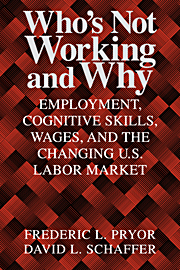Book contents
1 - The Changing Labor Market
Published online by Cambridge University Press: 25 March 2010
Summary
The period from 1970 to 1996 represents a time of dramatic change in the U.S. labor market. The manufacturing sector has been shrinking and restructuring while the service sector has been growing. Jobs of all types have moved out of the inner cities and into the suburbs. Increased international trade and competition has helped some industries expand their domestic output while others have been forced to scale back, shut down, or move their facilities abroad. Well-educated employees with decades of experience have become as fearful about layoffs as younger less-educated workers. Legal and illegal immigration has continued at high levels, creating more competition for many entry-level jobs. The technology changes associated with the computer revolution have continued to modify the nature of many jobs. Women have become just as likely as men to get a university degree, and almost as likely to seek paid work. The financial rewards to the most successful workers in the labor market have grown dramatically, while those to most other workers have shrunk. The quality of public education, at least in many urban areas, has declined precipitously.
These phenomena have received wide attention in both the academic and popular press. Hardly a month goes by without a new book appearing – by an economist, a sociologist, a business executive, or a journalist – attempting to explain why these changes are occurring and what they mean for the future. Our book follows in this tradition – but with a few key differences.
- Type
- Chapter
- Information
- Who's Not Working and WhyEmployment, Cognitive Skills, Wages, and the Changing U.S. Labor Market, pp. 1 - 18Publisher: Cambridge University PressPrint publication year: 1999



